What would your future-you have to say to you?
The no-pants guide to spending, saving, and thriving in the real world.
What would your future-you have to say to you?
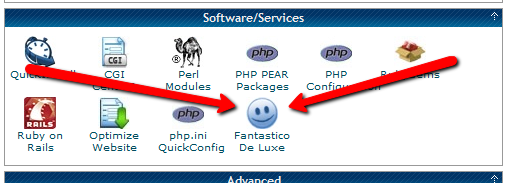
In this installment of the Make Extra Money series, I’m going to show you how to set up a WordPress site. I’m going to show you exactly what settings, plugins, and themes I use. I’m not going to get into writing posts today. That will be next time.
I use WordPress because it makes it easy to develop good-looking sites quickly. You don’t have to know html or any programming. I will be walking through the exact process using Hostgator, but most hosting plans use CPanel, so the instructions will be close. If not, just follow WordPress’s 5 minute installation guide.
Assuming you can follow along with me, log in to your hosting account and find the section of your control panel labeled “Software/Service”. Click “Fantastico De Luxe”.

On the Fantastico screen, click WordPress, then “New Installation”.
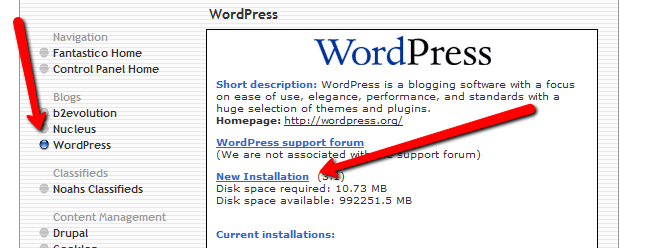
On the next screen, select your domain name, then enter all of the details: admin username, password, site name, and site description. If you’ll remember, I bought the domain http://www.masterweddingplanning.net. I chose the site name of “Master Wedding Planning” and a description of “Everything You Need to Know to Plan Your Wedding”.
Click “install”, then “finish installation”. The final screen will contain a link to the admin page, in this case, masterweddingplanning.net/wp-admin. Go there and log in.
After you log in, if there is a message at the top of the screen telling you to update, do so. Keeping your site updated is the best way to avoid getting hacked. Click “Please update now” then “Update automatically”. Don’t worry about backing up, yet. We haven’t done anything worth saving.
Next, click “Settings” on the left. Under General Settings, put the www in the WordPress and site URLs. Click save, then log back in.
Click Posts, then Categories. Under “Add New Category”, create one called “Misc” and click save.
Click Appearance. This brings you to the themes page. Click “Install Themes” and search for one you like. I normally use Headway, but before I bought that, I used SimpleX almost exclusively. Your goal is to have a simple theme that’s easy to maintain and easy to read. Bells and whistles are a distraction.
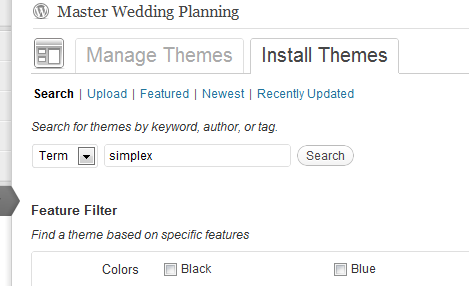
Click “Install”, “Install now”, and “Activate”. You now have a very basic WordPress site.
A plugin is an independent piece of software to make independent bits of WordPress magic happen. To install the perfect set of plugins, click Plugins on the left. Delete “Hello Dolly”, then click “Add new”.
In the search box, enter “plugin central” and click “Search plugins”. Plugin Central should be the first plugin in the list, so click “install”, then “ok”, then “activate plugin”. Congratulations, you’ve just installed your first plugin.
Now, on the left, you’ll see “Plugin Central” under Plugins. Click it. In the Easy Plugin Installation box, copy and paste the following:
All in One SEO Pack Contact Form 7 WordPress Database Backup SEO SearchTerms Tagging 2 WP Super Cache Conditional CAPTCHA for WordPress date exclusion seo WP Policies Pretty Link Lite google xml sitemaps Jetpack by WordPress.com
Click “install”.
On the left, click “Installed Plugins”. On the next screen, click the box next to “Plugins”, then select “Activate” from the dropdown and click apply.
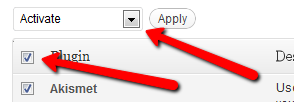
Still under Plugins, click “Akismet Configuration”. Enter your API key and hit “update options”. You probably don’t have one, so click “get your key”.
The only tool I worry about is the backup. It’s super-easy to set up. Click “Tools”, then “Backup”. 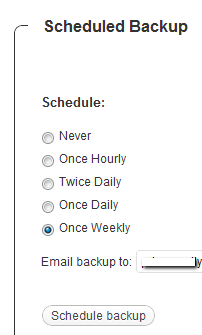
Scroll down to “Schedule Backups”, select weekly, make sure it’s set to a good email address and click “Schedule Backup”. I only save weekly because we won’t be adding daily content. Weekly is safe enough, without filling up your email inbox.
There are a lot of settings we’re going to set. This is going to make the site more usable and help the search engines find your site. We’re going to go right down the list. If you see a section that I don’t mention, it’s because the defaults are good enough.
Set the Default Post Category to “Misc”.
Visit this page and copy the entire list into “Update Service” box. This will make the site ping a few dozen services every time you publish a post. It’s a fast way to get each post indexed by Google.
Click “Save Changes”.
Uncheck everything under “Email me whenever…” and hit save. This lets people submit comments, without actually posting the comments or emailing me when they do so. Every once in a while, I go manually approve the comments, but I don’t make it a priority.
Select “Custom structure” and enter this: /%postname%/
Click save.
Set the status to “Enabled”, then fill out the site title and description. Keep the description to about 160 characters. This is what builds the blurb that shows up by the link when you site shows up in Google’s results.
Check the boxes for “Use categories for META keywords” and “Use noindex for tag archives”.
Click “Update Options”.
Check the boxes to remove each of the dates and set the alt text to “purpose” or something. This will suppress the date so your posts won’t look obsolete.
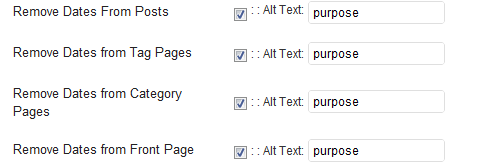
This plugin reinforces the searches that bring people to your site. It’s kind of neat. Skip the registration, accept the defaults and hit save.
Scroll to the bottom and click import. We’ll come back to this.
Select “Caching On” and hit save.
Across the top of the screen should be a giant banner telling you to connect to WordPress.com and set up Jetpack. You’ll need an account on WordPress.com, so go there and set one up. After authorizing the site, you’ll be brought back to the Jetpack configuration screen. Click “Configure” under “WordPress.com Stats”. Take the defaults and hit save.
On the contact configuration page, copy the code in the top section. You’ll need this in a moment.
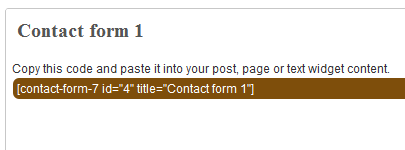
Now, we going to create a couple of static pages. On the left, click “Pages”, then “Add new”.
Name the first page “Contact” and put the contact form code in the body of the page. Hit publish.
Under Appearance, click “Menu”. Enter a menu name and hit save.
Then, under “Pages”, click the box next to “Contact”, “Disclaimer”, and any other policies you’d like to display. Hit save.
Also under Appearance, click “Widgets”. This is where you’ll select what will display in the sidebar. All you have to do is drag the boxes you want from the middle of the page to the widget bar on the right. I recommend Text, Search, Recent Posts, Popular Search Terms and Tag Cloud. In the text box, just put some placeholder text in it, like “Product will go here”. We’ll address this next time.
We’re not going to worry about getting posts in place, yet. That will be the next installment. However, the steps in the next installment could take 2 weeks to implement, and we want Google to start paying attention now. To make that happen, we need to get a little bit of content in place. This won’t be permanent content. It’s only there so Google has something to see when it comes crawling.
To get this temporary, yet legal content, I use eZineArticles. Just go search for something in your niche that doesn’t look too spammy.
Then, click “Posts”, then delete the “Hello World” post. Click “Add new”. Copy the eZine article, being sure to include the author box at the bottom, and hit publish.
To see your changes, you may have to go to Settings, then WP Cache and delete the cache so your site will refresh.
Congratulations! You now have a niche blog with content. It’s not ready to make you any money, yet, but it is ready for Google to start paying attention. In the next installment, I’ll show you how I get real unique content and set it up so Google keeps coming back to show me the love.
Today, I am continuing the series, Money Problems: 30 Days to Perfect Finances. The series will consist of 30 things you can do in one setting to perfect your finances. It’s not a system to magically make your debt disappear. Instead, it is a path to understanding where you are, where you want to be, and–most importantly–how to bridge the gap.
I’m not running the series in 30 consecutive days. That’s not my schedule. Also, I think that talking about the same thing for 30 days straight will bore both of us. Instead, it will run roughly once a week. To make sure you don’t miss a post, please take a moment to subscribe, either by email or rss.
Today we’re going to look at ways to boost your income.
People spend a lot of time talking about ways to reduce your expenses, but there is a better way to make ends meet. If you make more money, you will—naturally—have more money to work with, which will make it easier to balance your expenses. I’ve found it to be far less painful to make more money than to cut expenses I enjoy.
I can hear what you’re thinking. It’s easy to tell people to make more money, but what about telling them how? Guess what? I’m going to tell you how to make money because I rock.
By far, the simplest way to make more money is to convince whoever is paying you to pay you more for what you are already doing. In other words, get a raise. I know that’s easy to say. Money’s tight for a lot of companies and layoffs are common. None of that matters. Your company knows that hiring someone new will involve a lot of downtime during training. If you’ve been visibly doing your job, and the company isn’t on the brink of failure, it should be possible to get a bit of the budget tossed your way.
Another simple idea is to get a second job. Personally, I hate this idea, but it works wonders for some people. Gas stations and pizza stores offer flexible schedules and they are always hiring. If they aren’t willing to work with your schedule, or it doesn’t work out, you can always quit. This isn’t your main income, after all.
My favorite option is to create a new income stream. What can you do?
Take a piece of paper and a close friend and brainstorm how you can make some money. Write down every type of activity you have ever done or ever wanted to do. Then write down everything you can think of that other people who do those activities need or want. Remember, during a brainstorming session, there are no stupid ideas. Take those two lists and see if there is any product or service you can provide.
You can start a blog—although don’t expect to generate much money early—or try writing for some revenue-sharing article web sites, like hubpages or squidoo. Other options include affiliate marketing, garage sale arbitrage(buying “junk” at garage sales, fixing it up and selling it), or even doing yard work for other people.
One interesting business I’ve seen lately is a traveling poop-scooper. These people travel around and scoop poop out of ddog-owners’ yards. Business booms in the spring when the snow melts, but it can be an ongoing income, since dogs don’t stop pooping.
Raising your income can make it easier to pay your bills, pay off your debt, or even taking nice vacations. How have you made some extra cash?
This week, I spent more than 2 hours, 20 emails, and 30 miles trying to convince UPS and Barnes & Noble to get me a Nook that I paid for 3 weeks ago. Hopefully, I’ll have it early this week. If not, I’m giving up. The only other action I’m willing to take to get this resolved is to call my credit card company and file a chargeback.
Fun!
I am on the Slow Carb Diet. At the end of the month, I’ll see what the results were and decide if it’s worth continuing. For those who don’t know, the Slow Carb Diet involves cutting out potatoes, rice, flour, sugar, and dairy in all their forms. My meals consist of 40% proteins, 30% vegetables, and 30% legumes(beans or lentils). There is no calorie counting, just some specific rules, accompanied by a timed supplement regimen and some timed exercises to manipulate my metabolism. The supplements are NOT effedrin-based diet pills, or, in fact, uppers of any kind. There is also a weekly cheat day, to cut the impulse to cheat and to avoid letting my body go into famine mode.
I’m measuring two metrics, my weight and the total inches of my waist , hips, biceps, and thighs. Between the two, I should have an accurate assessment of my progress.
Weight: I have lost 41 pounds since January 2nd. That’s no progress since last week. I’m still doing push-ups every day, so it’s not surprising that I’m flunking weight loss.
Total Inches: I have lost 22.5 inches in the same time frame, up half an inch since last week.
Five Cent Nickel had a post on tipping. I always tip, but I don’t consider 15% to be a requirement. If the service sucks, I tip just a few cents. If the service is great, I easily and always clear 20%. A friend tried telling me that servers expect 20% to be standard, but that’s nuts. They aren’t the people who get to make that decision.
Money Crashers talked about traveling for free. In anticipation of the Financial Blogger Conference in October, I opened a travel rewards card. I’m hoping to make the trip for free.
I watched a TedTalk yesterday about teaching kids about electricity with homemade play-dough. This is a project that will be happening.
Narrow Bridge Finance ran my post, Monsters, while I ran his, Living the High Life, for the Yakezie blog swap, answering the question “What motivates you financially?”
Negotiating Superstar was included in the Carnival of Personal Finance.
5 Ways to Change Your Spending Habits was included in the Totally Money Blog Carnival.
Thank you! If I missed anyone, please let me know.
There are so many ways you can read and interact with this site.
You can subscribe by RSS and get the posts in your favorite news reader. I prefer Google Reader.
You can subscribe by email and get, not only the posts delivered to your inbox, but occasional giveaways and tidbits not available elsewhere.
You can ‘Like’ LRN on Facebook. Facebook gets more use than Google. It can’t hurt to see what you want where you want.
You can follow LRN on Twitter. This comes with some nearly-instant interaction.
You can send me an email, telling me what you liked, what you didn’t like, or what you’d like to see more(or less) of. I promise to reply to any email that isn’t purely spam.
Have a great week!
This is a guest post written by Jason Larkins. He writes at WorkSaveLive – a blog he started to help people change the way they think about their finances, careers, and lives.
Who doesn’t like to buy stuff?
Okay…I’m sure there are a few of you out there that take pride in never buying a new “toy,” but I know personally that I LOVE stuff!
Not to the point that I make dumb financial decisions that jeopardizes my family’s financial well-being, but I do have that natural American desire to have nice things and to be able to do fun stuff!
If you’re in the market to buy a Big-Ticket item (i.e. a new car, TV, or other technology gadget), what are some of the things you should be thinking through as you contemplate making the purchase?
The first mistake people make is buying on impulse. The massive majority of Americans don’t even have a thought process when it comes to buying toys, so that’s why I decided to dedicate a post on a few things you should ponder.
1. Avoid spending extra for add-ons, or features, that you’re never going to use.
It is easy to get an appliance or technology gadget that has a ton of amazing features on it – but why pay for them if you won’t use them?
Consider buying the item that may be a step below what you’re looking at.
I know that I personally love the thought of having an Ipad 2, but am I really going to utilize it to it’s full capabilities?
Probably not!
It doesn’t mean I shouldn’t have one, but it does mean I can look at the older Ipad and save some money. Or, I can avoid the purchase altogether if I don’t think it’s going to be worth the money.
2. Be cautious with offers such as “no money down,” “90 days same as cash,” or “12 months interest free.”
Nearly 88% of the “90 days same as cash” offers are actually converted to payments because the purchaser couldn’t pay off the bill before the offer was up.
3. Don’t buy it just because it’s the cheapest.
Always be sure to do research prior to your purchase – check consumer reviews and product reviews. Saving money may not be worth it if the product breaks down quickly or doesn’t have the functionality that you’re looking for.
1. Prepare for large purchases and pay cash for them.
If you can’t pay cash for the item, then there is a good chance that you can’t afford it.
Determine how much money you will need to spend on a particular item and save up for it! This is going to help you in a couple of ways:
2. Buy at the end of the month, or at the end of the year!
Consumers rarely think of this, but it’s important for you to know that every store (and store manager) has monthly/yearly sales to report.
If they’re wanting to close out the month/year strong, they’re much more inclined to offer you a deal on whatever you’re buying!
3. Avoid the extended warranty!
Insurance (in general terms) is the act of transferring risk – the more people that pool money together to help mitigate risk (buy insurance), then the lower the cost of the insurance becomes.
The reason to avoid the extended warranties is because the cost you’re paying to cover your item also includes: commissions paid to the retail store, overhead for the insurance company (wages for employees, building costs, utilities, etc), and some profit for the insurance company as well.
Sure, you may be in the miniscule percentage of buyers that has their item break down on them, but the reality is that it’s unlikely.
If it was likely for your item to break down, then the insurance wouldn’t be available because it wouldn’t be a profitable endeavor for the insurance company (and they’d be out of business).
Whenever you’re buying something that has a large price tag, you should develop a process that you think through before buying it!
Always pay in cash, get a deal, and make sure you actually need everything you’re paying for.

“Saving is too hard.”
“I don’t know where to start.”
“How much should I save?”
“Who the heck are you to tell me what to do with my money?”
“Shut up, Jason.”
These are the things I hear when I start talking about getting a good strategy in place to save some money. Financial matters are intimidating to a lot of people. They’d rather not think about their money any more than they absolutely need to, if that much. Here, I’m breaking it down to some simple steps to make saving easy.
1. Get motivated. Why do you want to save some money? Are you trying to make a secure future, or do you just want to buy a new toy? These are the kind of questions you have to ask yourself. Nobody else can tell you why you want to make changes to your lifestyle, and nobody else’s reasons matter in the least. Saving money is something you have to do for you.
2. Figure out how much you can save. Generally, you’re going to need a budget so you can figure out what you can afford to save, but not always. If you are making ends meet, then you get a raise, you can obviously afford to bank the difference. If you do that, you’ll never even notice the missing money. If you try to save so much your mortgage goes unpaid, you’re plan is doomed to failure.
3. Open an account at a new bank. The biggest problem I used to have when I was trying to save was that it was too easy to get the money. Every time I checked the balance of my checking account, I saw the balance in the savings account. Worse, it took seconds to transfer that money from my savings account to my attached checking account. Every time I wanted to see if I could afford whatever toy I was looking at, I’d see money that wasn’t earmarked for anything in particular. Naturally, that money got spent more often that it was ignored and allowed to grow. Now, I can completely forget about the money.
4. Automate. I’ve automated everything I can. All of my bills are paid automatically, except for one company that insists on quarterly paper invoices. I’ve got $665(neighbor of the beast!) automatically transferred to my INGDirect account, to get divided between my various savings goals, including a fund for my semi-annual property tax payments and a fund to pay for the braces we haven’t actually had to buy yet, but will in a couple of years. The money disappears into a bank I don’t use for my day-to-day expenses and grows completely out of sight. Every once in a while, I look at the account and get surprised by how much has accumulated.
5. Get rich. Once you’ve got the other four steps in place, all you’ve got to do is let it work. Over time, you will build wealth in a way that may surprise you. Your goal at this point is to do nothing new. Every once in a while, you can pull out some money and tuck it into an investment account to get some real growth going for you.
“Thank you.”
“You’re the best.”
“What would I do without you?”
“How can I show you my appreciation? <wink><wink>”
“What the heck are you doing with my wife?”
These are the things I always hope to hear after sharing my strategies to save money.